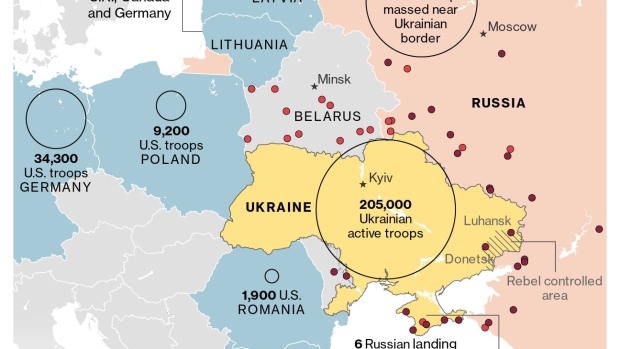Feb 13, 2022
Standoff With Russia Over Ukraine Heads Into Most Tense Week Yet
, Bloomberg News

(Bloomberg) -- Tensions over Russia’s military buildup near Ukraine are entering a potentially decisive week, with the U.S. warning an invasion may be imminent and President Vladimir Putin accusing America of failing to meet his demands.
U.S. National Security Advisor Jake Sullivan, who on Friday cited the risk that Russia will attack or seek to ignite conflict within Ukraine this week, told CNN on Sunday there’s “a distinct possibility that there will be major military action very soon.”
The U.S. and its European allies have been pressing Putin for weeks to pull back an estimated 130,000 troops massed near Ukraine, but a frenzy of diplomatic activity -- including key leaders cycling through Moscow for talks with Putin -- has failed to produce an off-ramp.
A phone call on Saturday between Putin and U.S. President Joe Biden that went for just over an hour saw them reiterate their positions without any apparent progress. Russia has repeatedly denied it plans to invade its neighbor and Russian officials accuse the U.S. of stoking “hysteria.”
Efforts to deescalate the situation are taking on even greater urgency after the latest U.S. warnings. America had previously said it believed a potential conflict could come later in February, but Sullivan on Friday said the U.S. now believes Putin could move before the Beijing Winter Olympics -- hosted by his ally President Xi Jinping -- end on Feb. 20. Sullivan cited U.S. intelligence but did not set out specific evidence for the changed view.
Biden spoke with Ukrainian President Volodymyr Zelenskiy on Sunday, telling him the U.S. and other countries would act “swiftly and decisively” in the face of any aggression by Russia. Zelenskiy invited him to come to Kyiv. German Chancellor Olaf Scholz is due there on Monday to meet with Zelenskiy, before traveling onto Moscow on Tuesday.
But even as the U.S. and Europe threaten what they say would be severe economic penalties for Moscow, there are differences about how heavily to respond, especially for countries like Germany that rely on imports of Russian gas. Cutting Russia off from the global payments system known as Swift is highly unlikely. And Biden has said he would not send U.S. troops into Ukraine in the event of a conflict.
The U.S. and its allies have also made clear they do not know Putin’s final intentions. While Ukraine says it “understands all the current risks and is ready for any developments,” it does not perceive the danger to be as significant as the U.S. says. Zelenskiy said in a televised briefing on the weekend that panic was “the best friends for enemies.”
‘Unprecedented Hysteria’
While Sullivan said that diplomacy was “still open and available,” there has been no in-person summit between Biden and Putin since they sat down in Geneva in June 2021. Kremlin foreign policy aide Yuri Ushakov told reporters that the weekend call took place in an atmosphere of “unprecedented hysteria by American officials about Russia’s allegedly imminent invasion of Ukraine.”
There was little in the way of fresh commentary from the Kremlin on Sunday. The Foreign Ministry accused the U.S. of a “militaristic psychosis” as it criticized the decision by “a number of countries” to withdraw their observers in the OSCE team monitoring a shaky cease-fire in Ukraine’s separatist Donbas region. The ministry said that Washington might be planning to exploit the Organization for Security and Cooperation in Europe’s mission to stage a “potential provocation.”
The Russian president is also yet to send a formal response to U.S. proposals on security in Europe, although a U.S. official said a reply is expected soon. Those proposals were made after Moscow demanded guarantees including that NATO never allow Ukraine to join and that the military alliance pull back its presence in eastern Europe. Putin told Biden on Saturday that the responses to his security demands did not address the Kremlin’s key concerns, Ushakov said.
It comes as tens of thousands of Russian troops hold joint exercises in Belarus, which shares a border with Ukraine. Those exercises are also set to finish on Feb. 20, and Moscow has said its soldiers will then return to base.
U.S. efforts to hem in Russia have included several months of increasing warnings about the military buildup along the Ukrainian border, the potential for Russian cyberattacks and what it says is the possibility of a Russian “false-flag” operation against its own forces as a pretext for an invasion. The U.S. has not provided specific detail on those claims.
“We are putting forward this intelligence to stop a war,” Sullivan told CNN.
Finnish President Sauli Niinisto, a key conduit between Moscow and the West, told the New York Times in an interview that he had noticed a recent change in Putin.
“His state of mind, the deciding, decisiveness -- that is clearly different,” said Niinisto, who spoke at length with Putin recently. He said he believed Putin felt he had to seize on “the momentum he has now,” the Times reported.
Niinisto said it was hard to imagine things returning to the way they were, with the likely options now being Russia pressuring Europe and extracting demands from Washington for the foreseeable future, or “warfare,” according to the newspaper.
©2022 Bloomberg L.P.